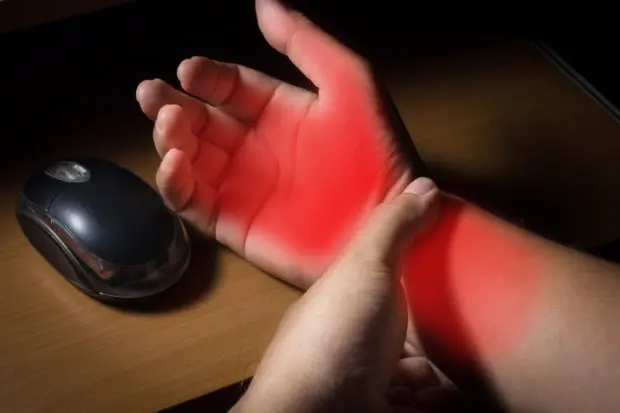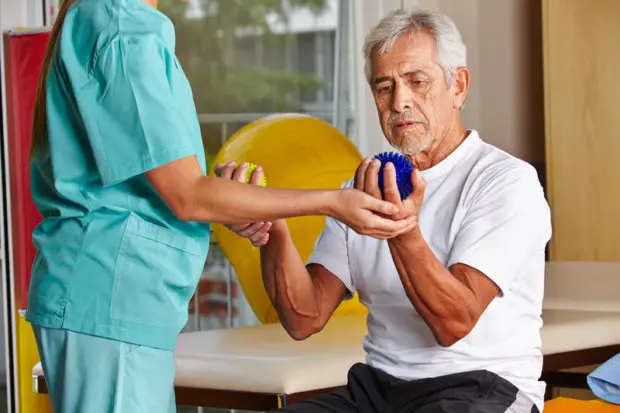Carpal tunnel syndrome (CTS) is a very common injury of the hand, especially with repetitive motions or overusing your hands. This syndrome is named for tendon injury or inflammation that happens in the hand in the area of the carpal tunnel in the wrist. Find out how to avoid carpal tunnel syndrome, what causes it and how it is treated if you already have it!
Carpal Tunnel 101
The National Institute of Neurological Disorders and Stroke (NINDS), describe carpal tunnel syndrome as the “most common and widely known of the entrapment neuropathies in which the body’s peripheral nerves are compressed or traumatized.” You have close to 100 billion nerve cells throughout your body, all of which send information from that area of your body to your spinal cord and brain. It is through that information provided by nerves that you can feel hot and cold, pain or pleasure, and countless other sensations.
The carpal tunnel in your body is the space in your wrist where the median nerve passes. This space in your wrist allows the median nerve to pass through this area, up through the rest of your arm. When you do a repetitive motion over and over (such as typing), it can irritate the area of your wrist where this small tunnel lies.
When that happens, tendon swelling in the area makes the tunnel shrink, blocking a lot of your nerve sensations. Even though nerve signals are getting blocked, patients generally feel chronic pain in a specific area of their wrist, which is what indicates that the condition is CTS. Most patients have chronic or sharp pain with movement. Others have burning, tingling or a “pins and needles” feeling, stiff fingers and weakness that worsens over time.
In-Office Professional Treatment
Carpal tunnel can become worse quickly without treatment. Inflammation can cause the pain to become severe and the more the nerve becomes injured, the longer treatment can take. That is why you want to seek professional treatment at the first sign of injury and pain. We address all the areas in your hand where a nerve could be entrapped. You will either have a hand injury, carpal tunnel or neuropathy caused by a chronic condition.
If the issue is CTS, we provide you with strengthening and stretching exercises to build your wrist strength back up. The right exercises can actually reduce the swelling you have, which will soothe the chronic pain and symptoms you’re experiencing. There are many pain-management options as well that can help you get through the day without you having to use narcotics. If needed, we can do nerve testing to rule out potential wrist problems or injuries if we find you don’t actually have carpal tunnel syndrome. For patients who are in chronic pain right then, we can provide anti-inflammatory injections that will calm the irritated and swollen nerve tissues down so you can actually heal.
Take Healing Measures at Home
One of the best ways to prevent and help treat CTS at home is to avoid repetitive motions. You can completely heal from carpal tunnel issues, only to have them start up again later on because you haven’t changed your habits. If you work at a job with repetitive movements, or you’re always doing the same hobbies or exercises with your hands, switch things up each day. When you work on something for an extended period of time, do hand exercises, stretches and motions other than the repetitive motion you do.
You can also:
- Stop any activity when you are starting to feel even the slightest hint of soreness or pain. This is often when people end up hurting themselves because they don’t stop at the first sign.
- Take over-the-counter medication to help reduce pain and inflammation.
- Get good nutrition. Eating right can help boost healing and prevent cellular damage.
- Change the way you hold objects.
- Keep your wrist in a neutral position and avoid flexing it too much in one direction or the other.
- Stay active. Get exercise for 30 minutes a day, 5 days a week, making sure that you are very careful with exercises that involves your hands. Moderate exercise can strengthen your muscles so injuries happen less frequently or not at all.
- Don’t sleep on your hands or wrists, especially in a bent position.
- Lift with your arms instead of your hands or fingers.
- Use KT tape or other stabilizing aids as instructed.
Help and Healing
If you have carpal tunnel syndrome, try this methods for relieving them at home when you are outside the office:
- Use the wrist splint we prescribe you so that your median nerve can rest.
- Ice the area as it swells and heat the area as instructed to help with pain. Icing and heat should only be done for 5-10 minutes, several times a day unless otherwise instructed.
- Do gentle wrist stretching in the area. You can learn proper technique in our office.
- Gentle massage several times a day in your palm and wrist area to boost circulation and break up inflammation.
- Protect your hands during work or exercise with proper protective or stabilizing gloves.
- Avoid vibrating tools (such as power tools) or use protective anti-vibration products so you don’t upset the healing nerve.
Carpal tunnel syndrome simply happens without many people realizing what is going on with their hands. Once you know what this condition is, you can take proper measures to prevent it and treat it. Professional help is the quickest and best way to recover from your injury so that you can get back to normal life again. For our therapies, a medical evaluation and to get started with your treatment, call Spine Correction Center at (970) 658-5115!



